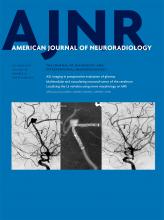We appreciate the comments by Gallerini et al regarding our recently published Clinical Report on patients with minor acute ischemic stroke syndromes and underlying large-vessel occlusion (LVO) in the anterior circulation.
We agree that in most stroke centers today, there is equipoise as to whether to transfer these patients to immediate mechanical thrombectomy (MT) or to offer thrombolysis (if possible) only, monitor the clinical course, and perform MT in case of clinical deterioration. Evidence from the recent randomized MT trials is lacking, and the nonrandomized evidence is scarce. In our experience, rescue MT, compared with immediate MT, may not be optimal in these patients. Haussen et al1 also compared the impact of immediate MT (n = 10) versus initial medical treatment (n = 22), including rescue thrombectomy if there was clinical deterioration based on the NIHSS difference from admission to discharge. They found that patients with immediate MT had more NIHSS improvement (−2.5 versus 0; P < .01) and a nonsignificantly better clinical outcome at 90 days (mRS 0–2: 100% versus 77%; P = .15). We showed the same trend favoring immediate MT; good outcomes (mRS 0–2) were higher in patients with immediate MT (75%, n = 8) compared with patients with rescue MT (33%, n = 6).2 However, there are also reports that immediate MT might not be superior to initial best medical management, including rescue MT, or that immediate MT might be associated with an increased risk of symptomatic intracerebral hemorrhage.3,4
With regard to the results of their own cohort we would like to comment, that we believe that patients with isolated proximal carotid or vertebral occlusions and patent intracranial vessels are of a different kind. Emergency stent placement, rather than MT, might be necessary in some cases if insufficient collateral flow is present. Hence, their observed LVO rate of 11/21 (52%) is much higher than that expected for MT candidates. LVO rates for patients with acute ischemic stroke vary according to clinical severity but are present in around 10%–20% of all patients with mild symptoms.5 Furthermore, it has been estimated that 1 ICA or M1 occlusion can be detected for every 11.5 patients screened if the NIHSS score is 0–5.6 Of those, conditions in 20%–40% of patients may deteriorate rapidly.1,7 However, because current guidelines only recommend MT in patients with an NIHSS score of ≤6,8 acute vessel imaging in patients with milder symptoms is not routinely performed; hence, many of these cases are missed by only screening patients presenting with an NIHSS score of >5.9 We absolutely agree with Gallerini et al that the NIHSS should not be a defining criterion for performing CTA.
Unfortunately, as mentioned by Gallerini et al, PRISMS (NCT02072226; clinicaltrials.gov) will not be able to answer the question of how to proceed with the target population (ie, intracranial anterior or posterior LVO and mild symptoms) because participants will be randomized in a 1:1 ratio to receive, within 3 hours of last-known-well time, either of the following: 1) one dose of IV alteplase and 1 dose of oral aspirin placebo, or 2) one dose of IV alteplase placebo and 1 dose of oral aspirin, 325 mg). MT is not part of the protocol, and most the patients with LVO will present beyond 3 hours due to their mild symptoms.5
To summarize, given the lack of evidence and the conflicting reports of nonrandomized cohorts, a randomized controlled trial in the target population is warranted. Until then, in our opinion, individual treatment decisions, based on local experience, the availability of MT, and individual clinical and radiologic findings, are recommended.
References
- © 2017 by American Journal of Neuroradiology












